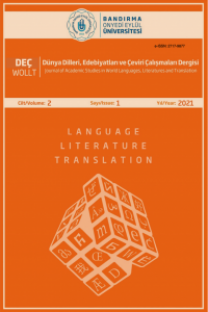Doğa ve Kadın Üzerindeki Ataerkil Tahakküm: Alice Walker'ın Şiirlerinin Ekofeminist Çözümlemesi
Bu çalışmanın amacı Alice Walker tarafından 1985 yılında yazılan “Horses Make a Landscape Look More Beautiful” [Atlar Manzarayı Daha Güzel Gösterir] başlıklı eseri ekofeminist bir bakış açısıyla çözümlemektir. Eser, 41 şiir ve iki epigrafik alıntıdan oluşmaktadır. Eserde yer alan şiirlerin çözümlenmesiyle sömürgeci güçler tarafından Amerika kıtasındaki yerli halkların geçim kaynaklarının ellerinden alınmasının ve doğanın sınırlarının ötesinde sömürülmesinin yazar tarafından açıkça eleştirdiğini görülmektedir. Ayrıca kadının ev işleri işlevine indirgenmesi ve erkeğe itaat etmesinin beklenmesiyle erkeğin kadın üzerindeki egemenliği de çözümlenen şiirlerde eleştirilen diğer bir durumdur. Bu çözümlemede, ekofeminizmin temel önermesi olduğu üzere doğanın ve kadının sömürülmesinin ilişkili olduğu sonucuna varılmıştır. Doğa ve kadın, erkeklere göre konumlarında “öteki” olarak görülmektedir ve bunun sonucu olarak erkekler, doğayı ve kadını üzerinde “doğal” bir tahakküm sahibi olunacak ve onlardan faydalanılabilecek nesneler olarak görürler. Bu bulgular, Mies ve Shiva’nın (1993) insan-doğa ve erkek-kadın dikotomilerini doğrulamaktadır. Bu dikotomilerde, birinci unsur “doğal olan” olarak görülmekteyken ikinci unsur, birinci unsur ile ilişkisine göre değer gören veya görmeyen unsur olarak kabul edilir. Tüm bu bulgular, ataerkil düzenin varlığını ve gücünü sürdürebilmek için ortaya koyduğu çabaları göz önüne sermektedir.
Anahtar Kelimeler:
Ekofeminizm, doğa, kadın, ataerkil sistem, tahakküm
Patriarchal Domination on Nature and Women: An Ecofeminist Analysis of Alice Walker’s Poems
The aim of this study is to analyze the book titled “Horses Make a Landscape Look More Beautiful” written by Alice Walker in 1985 from an ecofeminist point of view. The book is composed of 41 poems and two epigraphs. The analysis of the poems shows that the author overtly criticizes the colonizing powers who exploited the nature beyond its limits, taking the livelihood sources and resources of the native populations in the American continent. Moreover, the male domination over women is also criticized in the poems, with the woman reduced to the function of house chores and granted the role of obedience to the man. This analysis yields the result that the exploitation and oppression of nature is comparable to the exploitation and oppression of the woman, which is the basic premise of ecofeminism. Nature and woman are regarded as the “other” in their relation to man, as a result of which man considers them as the objects he is “naturally” entitled to benefit from dominate. This confirms Mies and Shiva’s (1993) dichotomies of “man” vs. nature and man vs. woman, in which the former element tends to be acknowledged as the “natural” one and the latter is regarded as the one that is valued or devalued in its relation to the “natural” former one. All this points to the efforts the patriarchal system makes to sustain its existence and power.
Keywords:
Ecofeminism, nature, women, patriarchal system, domination,
___
- Balanarayanan, S., and Vetrivel, K. (2012). Environmental degradation and human welfare: A critical study. ZENITH International Journal of Business Economics & Management Research, 2(5), 39-51.
- Gale, C. L. (1997). A study guide to Alice Walker's “Everyday use”. Detroit: Gale Research.
- Griffin, S. (1997). Ecofeminism and meaning. In Karen J. Warren (Ed.). Ecofeminism: Women, culture, nature (pp. 213-226). Bloomington and Indianapolis: Indiana University Press.
- June, P. B. (2015). Alice Walker on ecofeminist issues in her fiction: An interview. Women's Studies, 44(1), 99-116.
- Lakshmana, C. M. (2021). Regional experience of environmental degradation. A comparative study of India and China. In Kala S Sridhar and Li Jingfeng (eds.). The rise of India and China: Social, economic and environmental impacts, (pp. 257-289). London and New York: Routledge.
- Maamoun, N. (2019). The Kyoto protocol: Empirical evidence of a hidden success. Journal of Environmental Economics and Management, (95), 227-256.
- Marx, K. (2011). Kapital. (Volume I). (M. Selik and N. Satlıgan, Trans.). İstanbul: Yordam Kitap.
- Merchant, C. (1980). The death of nature: Women, ecology, and the scientific revolution. New York: HarperCollins.
- Mies, M. (1993). The myth of catching-up development. In Maria Mies and Vandana Shiva (Eds.). Ecofeminism (pp. 55-69). London: Zed Books.
- Mies, M, and Shiva, V. (1993). Ecofeminism. London: Zed Books.
- Ottuh, P. O. O. (2020). A critique of eco-feminism: An attempt towards environmental solution. International Journal of Environmental Pollution and Environmental Modelling, 3(4), 167-179.
- Sargisson, L. (2001) What's wrong with ecofeminism. Environmental Politics, 10(1), 52-64.
- Shiva, V. (1993). Homeless in the ‘global village’. In Maria Mies and Vandana Shiva (Eds.). Ecofeminism (pp. 98-107). London: Zed Books.
- Stearney, L. M. (1994). Feminism, ecofeminism, and the maternal archetype: Motherhood as a feminine universal. Communication Quarterly, 42(2), 145-159.
- Taddese, G. (2001). Land degradation: A challenge to Ethiopia. Environmental Management, 27(6), 815-824.
- Vance, L. (1993). Ecofeminism and the politics of reality. In Greta Gaard (Ed.). Ecofeminism: Women, animals, nature (pp. 118-145). Philadelphia: Temple UP.
- Walker, A. (1985). Horses make a landscape look more beautiful. London: The Women’s Press.
- Walker, A. (1997). Anything we love can be saved: A writer’s activism. New York: Random House Inc.
- Warren, K. (1997). Ecofeminism: Women, culture, nature. Bloomington: Indiana UP.
- Wenhua, L. (2004). Degradation and restoration of forest ecosystems in China. Forest Ecology and Management, 201(1), 33-41.
- Zinn, H. (1980). A people’s history of the United States: 1492-present. New York: Harper Perennial & Row.
- Yayın Aralığı: Yılda 2 Sayı
- Başlangıç: 2020
- Yayıncı: Bandırma Onyedi Eylül Üniversitesi
Sayıdaki Diğer Makaleler
Türkçede Samed Behrengi ve Çocuk Kitaplarının İzini Sürmek
Sözcelem çözümlemesi için (Aristoteles’ten Benveniste’e) birkaç tarihsel gönderim
Jean - Claude COQUET, Çevirmen: Sündüz KASAR
Çeviribilim ve İmgebilim Ekseninde Çeviride Erek Odaklı Yaklaşımların İncelenmesi
Doğa ve Kadın Üzerindeki Ataerkil Tahakküm: Alice Walker'ın Şiirlerinin Ekofeminist Çözümlemesi
Doğa ve Kadın Üzerindeki Ataerkil Tahakküm: Alice Walker'ın Şiirlerinin Ekofeminist Çözümlemesi
